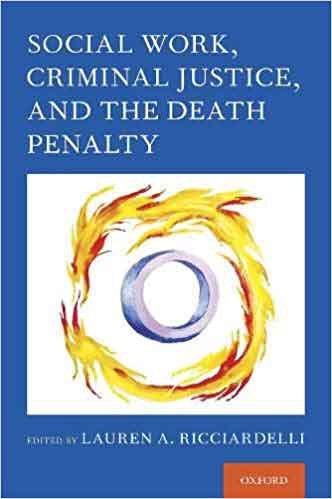Social Work, Criminal Justice, and the Death Penalty, by Lauren A. Ricciardelli (Ed.), Oxford University Press, ISBN: 9780190937232, 2020, 281 pages, $50.00.
Social Work, Criminal Justice, and the Death Penalty offers social workers across the profession a robust foundation for how to navigate the criminal justice system with respect to death penalty cases. It is formatted in three distinct but related sections.
Section I provides a historical understanding of the death penalty, along with court cases, while providing insight into legal procedures and judicial processes in a digestible fashion. It includes constitutional context while highlighting implications and the social work profession’s ethical obligations.
Section II focuses on the overarching theme of sociopolitical context that must be considered through a philosophical worldview while considering social theories and understanding the limits of neoliberalism and the impact of poverty, race, substance use, and gender on the criminal justice system. In addition, it explores the impact that death penalty cases have on service providers, including trauma and the public health impact the death penalty has on not only the inmate, but the whole system, including attorneys, prison staff, and jurors. The section provides a detailed plan for participation in advocacy work addressing the death penalty from a social justice perspective. It includes steps such as how to get involved in the process and gain understanding of the problems, as well as understanding the need to evaluate the advocacy project.
Section III focuses specifically on all aspects of the social worker’s role as it relates to the criminal justice system, including counseling, case management, and probation services. It also looks at how social workers are employed in police departments and skills needed for each role. An important aspect is the role of mental illness, intellectual disabilities, and the role of family, and how these areas are overlooked in the criminal justice system in particular as it relates to death penalty cases. There is attention to the issues of immigration and human rights, which are explored and understood through court decisions. Trauma and the role that the ACES study has in death penalty cases are considered, as well as how to follow a best practice strategy through a trauma-informed lens.
In review, this text offers the social worker in direct practice a wealth of information, providing a historical understanding as it relates to death penalty and the role of social workers at not only the micro level of services, but also the macro level. Furthermore, social workers will be equipped to have a better foundation and direction in regard to how to advocate and navigate the criminal justice system as they seek justice.
This text offers tangible steps for the social worker to support, engage, advocate, assess, and provide useful documents to assist clients and attorneys through the legal process of death penalty cases. Echoed throughout this text are skills that social workers bring that are so valuable in bringing about changes at the micro and macro levels in the field of criminal justice and the policy arena.
This text would be a key textbook to have in the social work, criminal justice, and history professor’s library and course syllabi for social policy, criminal justice, law, and social work practice. The educator can utilize the discussion sections from the various chapters to facilitate in-class or online discussions, as well as prompts for papers and research assignments.
Reviewed by Lara Vanderhoof, DSW, LMSW, MSW, Associate Professor of Social Work, Social Work Program Director, Tabor College.

